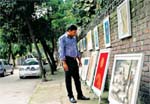 The fine arts market in Bangladesh is growing in size and stature every year but not in an organised way, with no regulations governing the market growth and little research to evaluate its pros and cons and
The fine arts market in Bangladesh is growing in size and stature every year but not in an organised way, with no regulations governing the market growth and little research to evaluate its pros and cons and
formulate strategies based on the findings.
While the market is almost exclusively based in the capital city and its size smaller than expected, available research indicates that the number of buyers is increasing every year.
Most of these buyers prefer to collect artworks by renowned artists although sometimes they are tricked into buying counterfeit works. The young artists, on the other hand, are struggling to carve out a place for themselves in the market which tends to be favourable towards artists of considerable repute.
Researcher Nazia Nabi in her paper entitled ‘Marketing of Fine Arts: A Study on Fine Arts of Bangladesh,’ published in World Review of Business Research in March 2014, said there has been a significant rise in the number of buyers and collectors in the past few years.
‘In the last five years, the sales volume of artwork rose approximately by 30% each year,’ she said, adding that this growth is ‘demonstrative of the thriving art scene’ in Bangladesh. She concluded by saying that ‘merit does not always govern’ the purchasing trends.
Artist Mohammad Iqbal said he is upset by the tendency to not appreciate the merit of young artists. ‘Young artists might someday find their place in the market, but right now, the situation is not in their favour. The buyers are not showing much interest in their works,’ he said, adding that demands for art need to be created to change the situation.
Senior artist Jamal Ahmed spoke in the same vein, saying the merit of young artists is often overlooked. ‘Artists can’t sell their works unless they have earned considerable reputations. The higher their status and the media attention, the higher the demand of their works,’ he said.
While there are no conclusive data available on the sales of artworks, it is generally assumed that works by the classic masters are very high in demand. Some of their artworks were reported to have been sold at over Tk 1 crore each, whereas works of contemporary masters such as Shahabuddin Ahmed, Rafiqun Nabi and Kalidas Karmakar can easily fetch upwards of two or three millions.
‘In countries where there is a vibrant art market, you might come across over a hundred galleries in a single city. But in our country, you won’t not find a single gallery in most of the big cities – which might give the impression that our fine arts practices are limited to Dhaka only,’ said Jamal.
Professor Nisar Hossain pointed out several factors obstructing the growth of the market such as poor maintenance of sales records and illegal reproduction of artworks. ‘Most of our buyers do not have enough knowledge and information to make sensible purchasing decisions. They can easily be tricked into buying copies of master pieces,’ he said.
To come out of the irregularities prevalent in the art market, a concerted effort by the artists, curators, art-critics, galleries and buyers is necessary, said renowned sculptor Hamiduzzaman Khan.
‘It will take time for the market to emerge as a healthy one. But if everyone involved steps forward and contributes in their own way, I hope we will have a more diverse and vibrant art market in the country,’ he said.
-With New Age input




















